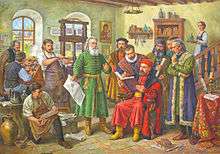Ostrog Bible


The Ostroh Bible (Ukrainian: Острозька Біблія, translit. Ostroz’ka Bibliya; Russian: Острожская Библия, translit. Ostrozhskaya Bibliya) was one of the earliest East Slavic translations of the Bible and the first complete printed edition of the Bible in Old Church Slavonic, published in Ostroh, in the Polish-Lithuanian Commonwealth (modern territory of Ukraine), by the printer Ivan Fyodorov in 1581 with the assistance of the Ruthenian Prince Konstantin Ostrogski.
The Ostroh Bible was translated not from the (Hebrew) Masoretic text, but from the (Greek) Septuagint. This translation comprised seventy-six books of the Old and New Testaments and a manuscript of the Codex Alexandrinus. Some parts were based on Francysk Skaryna's translations.
The Ostroh Bibles were printed on two dates: 12 July 1580, and 12 August 1581. The second version differs from the 1580 original in composition, ornamentation, and correction of misprints. In the printing of the Bible delays occurred, as it was necessary to remove mistakes, to search for correct textual resolutions of questions, and to produce a correct translation. The editing of the Bible detained printing. In the meantime, Fyodorov and his company printed other biblical books. The first were those that did not require correcting: the Psalter and the New Testament.
The Ostroh Bible is a monumental publication of 1,256 pages, lavishly decorated with headpieces and initials, which were prepared especially for it. From the typographical point of view, the Ostroh Bible is irreproachable. This is the first Bible printed in Cyrillic type. It served as the original and model for further Russian publications of the Bible.
The importance of the first printed Cyrillic Bible can hardly be overestimated. Prince Ostrogski sent copies to Pope Gregory XIII and tsar Ivan the Terrible, while the latter presented a copy to an English ambassador. When leaving Ostroh, Fyodorov took 400 books with him. Only 300 copies of the Ostroh Bible are extant today.
The Ostroh Bible was widely known in Ukraine, Russia, and Belarus, and also abroad. It is registered in the library of Oxford; its copies were owned by King Gustavus Adolphus of Sweden, the cardinal Barberini, many scientists and the public figures of that time. The Ostroh Bible was reprinted in Moscow in 1663.
The significance of the Ostroh Bible was enormous for Orthodox education, which had to resist strong Catholic pressure in Ukraine and Belarus.
References
- 1663 Reprint of The Ostroh Bible [revised by Arsenios the Greek, Zakariya Afanas'ev and two others, under the direction of the Patriarch Nikon] Reprint
External links
| Wikimedia Commons has media related to Ostroh Bible. |
- The Ostroh Circle and Bible from Ways of Russian Theology, by Fr. George Florovsky
- Ostrih Bible at the Encyclopedia of Ukraine